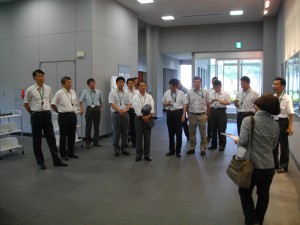Realising a big international project such as the International Linear Collider involves many issues beyond finalising the technical design. The Advanced Accelerator Association promoting science and technology (AAA), Japan’s industry-academia collaboration towards the realisation of the ILC, recently published a report to address such issues.
This report, entitled “ILC – Issues in construction of the ILC facility in the case of Japan,” was edited by the Construction Issue Working Group headed by Masakazu Yoshioka, professor at KEK. This working group was established under AAA’s Large Project Study Group, which studies comprehensive issues to realise the ILC in Japan. “In 2010, AAA published a report addressing the study of tunnel structure optimised for Japanese hilly rock sites,” he said. “This time, we made an extensive survey to list most of the issues in constructing the ILC facility in Japan, such as environmental assessment, local laws, electric power, earthquake, and so forth.”
The team consists of 49 experts from industry and academia who specialise in various areas such as construction, architectural design, electrical-power planning, and building services. “We basically fleshed out all the agendas,” said Yoshioka. The table of contents of the report covers broad items including laws and regulations, environment issues, infrastructure, and a study on the demands for the relaxation of regulations.
The basic philosophy in producing this report was based on Japan’s fourth science and technology policy issued in August last year. The editing team set down the principles of the policy as the basic philosophy for the report of how the ILC fits into it. In the report, the Japanese government listed visions for a future Japan and major goals Japan should aim for. “We recognised that one of those visions, for Japan to become a country that continues to create ‘knowledge’ assets and fosters science and technology as a culture, could be realised by building the ILC,” said Yoshioka. Japan’s policy states a commitment to the enhancement of globally top-level basic research, stressing the importance of building research centres that can work as a hub of international research networks. This also can be realised with the ILC.
Many of the items studied for the report were Japanese-specific issues since Japan lacks the experience to host a big international project. “There are many aspects of issues that need to be addressed,” Yoshioka said. “One example is laws and regulations. Many laws and regulations will be involved in realising the ILC and different authorities have jurisdiction over them.” In tackling the issue, AAA made a comprehensive list of laws and regulations and identified any problems in applying them in building the ILC.
Earthquake and electricity were two big themes in the report. “The contribution made by the experts from RIKEN was remarkable, especially on the electricity study,” said Yoshioka.
Through the editing process, the team identified that there is hardly any impact from a potential earthquake for building the ILC in Japan. The ground condition of two candidate sites were found stable and have good characteristics for tunneling. Also, no effect was observed on the precision instruments installed in the underground facilities in the Tohoku area.
Last September, the team visited the RI beam factory (RIBF) at the RIKEN Nishina Center for Accelerator-Based Science. RIBF has a co-generation system that increases the overall efficiency and reliability of a power supply that uses a gas turbine to drive an electrical generator, taking hot exhaust from the turbine into a steam generator. “It is crucial to secure a stable power supply to the ILC. The visit to RIBF provided us with important information,” said Yoshioka. RIBF is also a good example of an accelerator that was integrated into society for everyday purposes. “RIBF has a strong commitment to contribute to the local society. Their activities serve as a useful reference for the ILC.”
The team also identified many time-consuming issues, such as an environment assessment.
The report was submitted to Satoru Yamashita of the University of Tokyo, the chair of the AAA’s Large Project Study Group, to develop specific measures for each issue identified in the report. The English translation of the report will be published soon.


Recent Comments